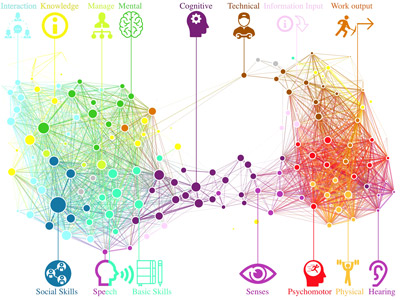Using AI to control energy for indoor agriculture
30 September 2024
Published online 26 July 2018
Links between skill sets prevent low-income workers from getting better-paying jobs.

© Ahmad Alabdulkareem
Enlarge image
The researchers used data from the US Department of Labor to determine which skills are specifically required for particular occupations and to create a measure of ‘skill complementarity’, or how likely two skills are to be useful in the same occupation. From the data, they built and algorithmically analysed the structure of a complementary skills network.
The algorithm grouped the network into two clusters, characterized as ‘socio-cognitive skills’, such as complex problem-solving, social perceptiveness, or persuasion, and ‘sensory-motor skills’, such as peripheral vision, stamina, or manual dexterity.
“It’s striking that the unsupervised algorithm detects a skillscape with two major clusters,” says David Autor, an MIT economist who wasn’t involved in the research. “It’s built from the ground up using fact patterns in the data that are not filtered through a theoretical lens, which suggests that this clustering is a pervasive and robust feature of the data.”
Combining this analysis with data from the Bureau of Labour Statistics, the researchers discovered that jobs relying more heavily on socio-cognitive skills had higher annual wages on average. Salary also increased with the number of skills required. Overall, “the skills of a job are more predictive than educational requirements or other factors,” says Ahmad Alabdulkareem, who spearheaded the project for his doctoral thesis at MIT.
"The skills of your current job are very predictive of what new skills you will acquire."
Nevertheless, the model does not capture many factors that affect salary. For example, logging workers are paid more than expected based on the job’s skill requirements, which are heavily sensory-physical. “That’s a job which has a huge amount of hazard, which increases the cost because of supply-and-demand,” says Alabdulkareem.
Frank MacCrory, an economist at Fordham University, who wasn't involved in this study, says that “a lot of research has looked at the effects of job market polarization, but without a ‘how’ and ‘why’ it's difficult to build real-world solutions. This research offers a plausible how and why.’”
The team also analysed how workers acquire new skills and how skill requirements change as workers switch jobs. They found limited mobility between the two skill clusters, perhaps because of the absence of jobs that rely on both types of skills, making it difficult for low-income workers to acquire the socio-cognitive skills needed for better paying jobs. “It’s like a ladder that’s missing a lot of rungs in the middle,” says Alabdulkareem.
“That was the most striking result to me,” he continues. “In principle, workers could easily have picked up new skills that aren’t complementary with their skill set, but we found that the skills of your current job are very predictive of what new skills you will acquire.”
Skills connecting low- and high-wage occupations are basic skills taught in secondary school, MacCrory notes. “Hopefully demonstrating that these are the ground-floor of high-paying jobs – not a college degree – will help turn policy-makers away from incentivizing everyone to go to college and towards earlier interventions for students and more effective interventions for displaced workers,” he adds.
Policy-makers can use these insights to guide and inform their decisions when designing training programs or other interventions in the labour market. Likewise, people can use the network, which is freely available on the Skillscape website, to help plan a career path by identifying jobs that will give them valuable new skills. “It’s useful as a map,” says Alabdulkareem. “It helps you manoeuvre and make decisions, but it's never going to give you the answer or tell you where to go.”
Alabdulkareem is moving to Saudi Arabia’s King Abdulaziz City for Science and Technology, which provided much of the funding for this study. In collaboration with the team at MIT, he plans to build recommendation tools on top of the analysis and to expand the research to cover other countries, including Saudi Arabia. Despite the structural constraints of the kingdom’s labour market, Alabdulkareem argues that the tool can still help planners.
doi:10.1038/nmiddleeast.2018.84
Stay connected: